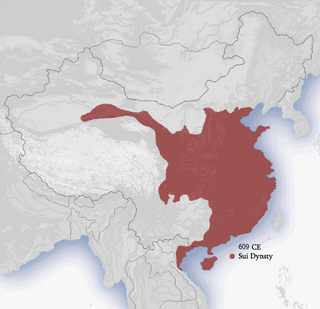
The Sui dynasty was a short-lived Chinese imperial dynasty that ruled from 581 to 618. The re-unification of China proper under the Sui brought the Northern and Southern dynasties era to a close, ending a prolonged period of political division since the War of the Eight Princes. The Sui endeavoured to rebuild the country, re-establishing and reforming many imperial institutions; in so doing, the Sui laid much of the foundation for the subsequent Tang dynasty, who after toppling the Sui would ultimately preside over a new golden age in Chinese history.

The Grand Canal is a system of interconnected canals linking various major rivers in North and East China, serving as an important waterborne transport infrastructure between the north and the south during Medieval and premodern China. It is the longest artificial waterway in the world and a UNESCO World Heritage Site.
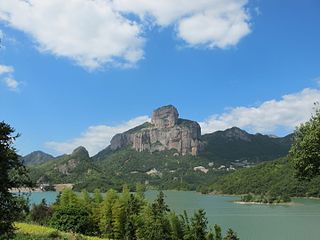
Zhejiang is an eastern coastal province of the People's Republic of China. Its capital and largest city is Hangzhou, and other notable cities include Ningbo and Wenzhou. Zhejiang is bordered by Jiangsu and Shanghai to the north, Anhui to the northwest, Jiangxi to the west and Fujian to the south. To the east is the East China Sea, beyond which lies the Ryukyu Islands. The population of Zhejiang stands at 64.6 million, the 8th largest in China. It has been called "the backbone of China" because it is a major driving force in the Chinese economy and being the birthplace of several notable people, including the Chinese Nationalist leader Chiang Kai-shek and entrepreneur Jack Ma. Zhejiang consists of 90 counties.
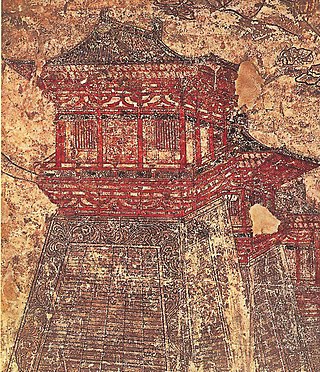
Chang'an is the traditional name of Xi'an. The site has been inhabited since Neolithic times, during which the Yangshao culture was established in Banpo, in what is now the city's suburbs. Furthermore, in the northern vicinity of modern Xi'an, Qin Shi Huang of the Qin dynasty, China's first emperor, held his imperial court and constructed his massive mausoleum guarded by the Terracotta Army.

Yuyao is a county-level city in the northeast of Zhejiang province, China. It is under the jurisdiction of the sub-provincial city of Ningbo.

Ningbo is a sub-provincial city in northeast Zhejiang province, People's Republic of China. It comprises six urban districts, two satellite county-level cities, and two rural counties, including several islands in Hangzhou Bay and the East China Sea. Ningbo is the southern economic center of the Yangtze Delta megalopolis. The port of Ningbo–Zhoushan, spread across several locations, is the world's busiest port by cargo tonnage and world's third-busiest container port since 2010.

Zhoushan is an urbanized archipelago with the administrative status of a prefecture-level city in the eastern Chinese province of Zhejiang. It consists of an archipelago of islands at the southern mouth of Hangzhou Bay, off the mainland city of Ningbo. The prefecture's city proper is Dinghai on Zhoushan Island, now administered as the prefecture's Dinghai District. During the 2020 census, Zhoushan Prefecture's population was 1,157,817, out of whom 882,932 lived in the built-up area made of two urban districts of Dinghai and Putuo.
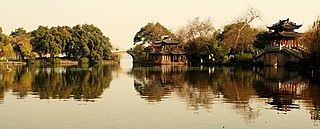
West Lake is a freshwater lake in Hangzhou, China. It is divided into five sections by three causeways. There are numerous temples, pagodas, gardens, and natural/artificial islands within the lake. Gushan (孤山) is the largest natural island and three artificial islands: Xiaoyingzhou (小瀛洲), Huixin Pavilion (湖心亭), and Ruan Gongdun (阮公墩) stand at the middle of the lake. Leifeng Pagoda (雷峰塔) and Baochu Pagoda (保俶塔) are separated by the lake. Mirroring each other, the basic pattern of "one mountain, two towers, three islands, three banks, and five lakes" is formed.
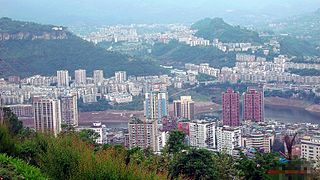
Wanzhou District is Chongqing's second most populated urban core area on the upper reaches of the Three Gorges of the Yangtze River in China. It is currently governed as a district of Chongqing Municipality, bordering Sichuan to the northwest and Hubei to the southeast. It was formerly known as Wanxian or Wan County. Prior to Chongqing's formation as a direct-controlled municipality, Wanzhou was part of Sichuan province. The urban core of Wanzhou is 228 km (142 mi) away from Chongqing's city proper.

Hallasan (Korean: 한라산) is a shield volcano on Jeju Island in South Korea. Its summit, at 1,947 m (6,388 ft), is the highest point in the country. The area around the mountain is a designated national park, named Hallasan National Park. Hallasan is commonly considered to be one of the three main mountains of South Korea, along with Jirisan and Seoraksan.
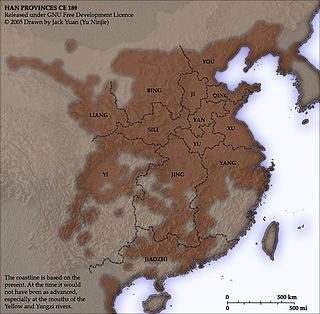
Zhou were historical administrative and political divisions of China. Formally established during the Han dynasty, zhou existed continuously for over 2000 years until the 1912 establishment of the Republic of China. Zhou were also once used in Korea, Vietnam and Japan.
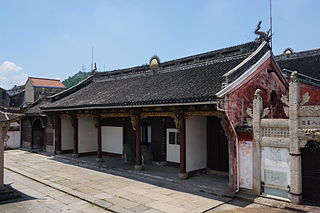
Shangyu District is a district of the prefecture-level city of Shaoxing in the northeast of Zhejiang province, China. At the 2010 census, its population in the built-up area was 779,412, up from 722,523 in the 2000 census. Shangyu is roughly fifty kilometers from north to south and about thirty kilometers from east to west. It makes up about one-fourth of the area of Shaoxing prefecture. Shangyu District is not part of the Hangzhou-Shaoxing built-up area as some countryside still prevent the city from being conurbated until now.
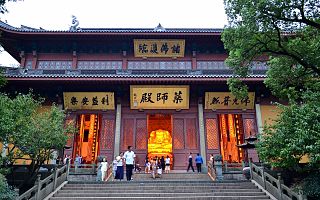
Lingyin Temple is a prominent Chan Buddhist temple near Hangzhou that is renowned for its many pagodas and grottos. Its name is commonly and literally translated into English as Temple of the Soul's Retreat.

Cixi, alternately romanized as Tzeki, is a county-level city under the jurisdiction of the sub-provincial city of Ningbo, in the north of Zhejiang province, China. As of the 2020 census, its population was 1,829,488. Its urban agglomeration built-up area, largely contiguous with Cixi plus the county-level city of Yuyao, had 3,083,520 inhabitants.

The Maijishan Grottoes, formerly romanized as Maichishan, are a series of 194 caves cut in the side of the hill of Maijishan in Tianshui, Gansu Province, northwest China.
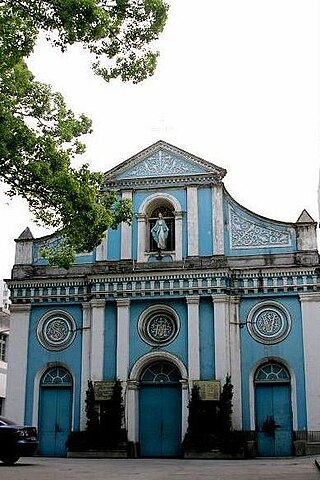
The Cathedral of Our Lady of the Immaculate Conception is a Roman Catholic cathedral, located at 415 Zhongshan Road North (中山北路415号) not far from Wulin Square (武林广场) in downtown Hangzhou, China. Since it is the only Catholic church in service within the city of Hangzhou itself, it is also known simply as Tiānzhǔ Táng (天主堂) or "the Catholic church".
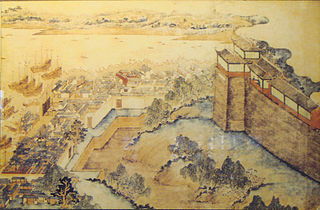
The Old City of Shanghai, also formerly known as the Chinese city, is the traditional urban core of Shanghai. Its boundary was formerly defined by a defensive wall. The Old City was the county seat for the old county of Shanghai. With the advent of foreign concessions in Shanghai, the Old City became just one part of Shanghai's urban core, but continued for decades to be the seat of the Chinese authority in Shanghai. Notable features include the City God Temple, which is located in the center of the Old City and is connected to the Yuyuan Garden. With the exception of two short sections, the walls were demolished in 1912, and a broad circular avenue built over the former wall and moat: the southern half was named the "Zhonghua Road" and the northern half the "Minguo Road".
The history of Zhengzhou, a city that is today the provincial capital of Henan Province, China spans over 10,000 years from its beginnings as a Neolithic settlement to its emergence as a trading port during the final years of the Qing dynasty.
Changsha has a history going back over 3000 years. It has grown to an important town of economy, culture and garrison in the southern area of Chu State. In the Later Tang dynasty (923-936), the king of Chu, Ma Yin, founded the Chu Kingdom (927-963) and set it as the capital, the city quickly became the largest and most important population, commercial and financial center in southern China. It was devastated by the Second Sino-Japanese War and the Wenxi Fire in 1938 but was quickly rebuilt. As of 2016, Changsha was ranked 13th of cities of China by comprehensive strength in 2016.
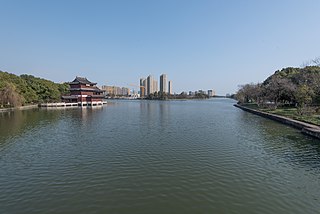
The Eastern Zhejiang or Zhedong Canal, also known as the Hangzhou–Ningbo or Hangyong Canal, is a major canal connecting Hangzhou, Shaoxing, and Ningbo in northern Zhejiang, China. It runs 239 kilometres (149 mi), connecting the Qiantang, Cao'e, and Yong watersheds with Hangzhou's terminus for the Grand Canal and Ningbo's ports on the East China Sea. Since 2013, it has been officially considered the southernmost section of the Grand Canal itself.



















